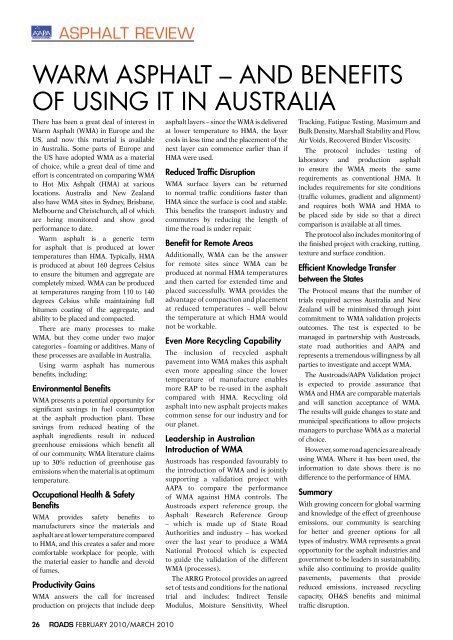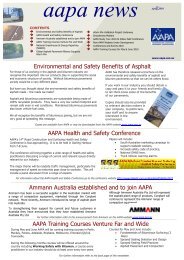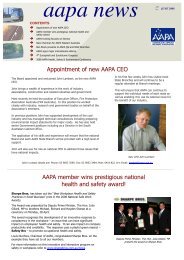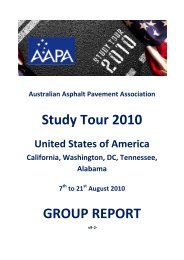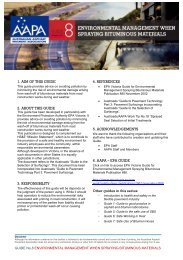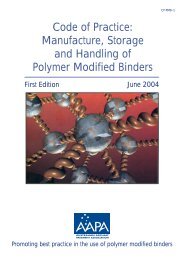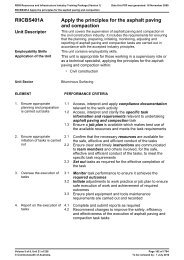Asphalt Review - Volume 29 Number 1 (February / March 2010)
Asphalt Review - Volume 29 Number 1 (February / March 2010)
Asphalt Review - Volume 29 Number 1 (February / March 2010)
- No tags were found...
You also want an ePaper? Increase the reach of your titles
YUMPU automatically turns print PDFs into web optimized ePapers that Google loves.
ASPHALT REVIEWWarm <strong>Asphalt</strong> – and benefitsof using it in AustraliaThere has been a great deal of interest inWarm <strong>Asphalt</strong> (WMA) in Europe and theUS, and now this material is availablein Australia. Some parts of Europe andthe US have adopted WMA as a materialof choice, while a great deal of time andeffort is concentrated on comparing WMAto Hot Mix Ashpalt (HMA) at variouslocations. Australia and New Zealandalso have WMA sites in Sydney, Brisbane,Melbourne and Christchurch, all of whichare being monitored and show goodperformance to date.Warm asphalt is a generic termfor asphalt that is produced at lowertemperatures than HMA. Typically, HMAis produced at about 160 degrees Celsiusto ensure the bitumen and aggregate arecompletely mixed. WMA can be producedat temperatures ranging from 110 to 140degrees Celsius while maintaining fullbitumen coating of the aggregate, andability to be placed and compacted.There are many processes to makeWMA, but they come under two majorcategories – foaming or additives. Many ofthese processes are available in Australia.Using warm asphalt has numerousbenefits, including:Environmental BenefitsWMA presents a potential opportunity forsignificant savings in fuel consumptionat the asphalt production plant. Thesesavings from reduced heating of theasphalt ingredients result in reducedgreenhouse emissions which benefit allof our community. WMA literature claimsup to 30% reduction of greenhouse gasemissions when the material is at optimumtemperature.Occupational Health & SafetyBenefitsWMA provides safety benefits tomanufacturers since the materials andasphalt are at lower temperature comparedto HMA, and this creates a safer and morecomfortable workplace for people, withthe material easier to handle and devoidof fumes.Productivity GainsWMA answers the call for increasedproduction on projects that include deepasphalt layers – since the WMA is deliveredat lower temperature to HMA, the layercools in less time and the placement of thenext layer can commence earlier than ifHMA were used.Reduced Traffic DisruptionWMA surface layers can be returnedto normal traffic conditions faster thanHMA since the surface is cool and stable.This benefits the transport industry andcommuters by reducing the length oftime the road is under repair.Benefit for Remote AreasAdditionally, WMA can be the answerfor remote sites since WMA can beproduced at normal HMA temperaturesand then carted for extended time andplaced successfully. WMA provides theadvantage of compaction and placementat reduced temperatures – well belowthe temperature at which HMA wouldnot be workable.Even More Recycling CapabilityThe inclusion of recycled asphaltpavement into WMA makes this asphalteven more appealing since the lowertemperature of manufacture enablesmore RAP to be re-used in the asphaltcompared with HMA. Recycling oldasphalt into new asphalt projects makescommon sense for our industry and forour planet.Leadership in AustralianIntroduction of WMAAustroads has responded favourably tothe introduction of WMA and is jointlysupporting a validation project withAAPA to compare the performanceof WMA against HMA controls. TheAustroads expert reference group, the<strong>Asphalt</strong> Research Reference Group– which is made up of State RoadAuthorities and industry – has workedover the last year to produce a WMANational Protocol which is expectedto guide the validation of the differentWMA (processes).The ARRG Protocol provides an agreedset of tests and conditions for the nationaltrial and includes: Indirect TensileModulus, Moisture Sensitivity, WheelTracking, Fatigue Testing, Maximum andBulk Density, Marshall Stability and Flow,Air Voids, Recovered Binder Viscosity.The protocol includes testing oflaboratory and production asphaltto ensure the WMA meets the samerequirements as conventional HMA. Itincludes requirements for site conditions(traffic volumes, gradient and alignment)and requires both WMA and HMA tobe placed side by side so that a directcomparison is available at all times.The protocol also includes monitoring ofthe finished project with cracking, rutting,texture and surface condition.Efficient Knowledge Transferbetween the StatesThe Protocol means that the number oftrials required across Australia and NewZealand will be minimised through jointcommitment to WMA validation projectsoutcomes. The test is expected to bemanaged in partnership with Austroads,state road authorities and AAPA andrepresents a tremendous willingness by allparties to investigate and accept WMA.The Austroads/AAPA Validation projectis expected to provide assurance thatWMA and HMA are comparable materialsand will sanction acceptance of WMA.The results will guide changes to state andmunicipal specifications to allow projectsmanagers to purchase WMA as a materialof choice.However, some road agencies are alreadyusing WMA. Where it has been used, theinformation to date shows there is nodifference to the performance of HMA.SummaryWith growing concern for global warmingand knowledge of the effect of greenhouseemissions, our community is searchingfor better and greener options for alltypes of industry. WMA represents a greatopportunity for the asphalt industries andgovernment to be leaders in sustainability,while also continuing to provide qualitypavements, pavements that providereduced emissions, increased recyclingcapacity, OH&S benefits and minimaltraffic disruption.26 ROADS FEBRUARY <strong>2010</strong>/MARCH <strong>2010</strong>


